Serving 567 students in grades 9-12, Triton Regional High School ranks in the top 30% of all schools in Massachusetts for overall test scores (math proficiency is top 50%, and reading proficiency is top 50%).
The percentage of students achieving proficiency in math is 45-49% (which is higher than the Massachusetts state average of 41%). The percentage of students achieving proficiency in reading/language arts is 60-64% (which is higher than the Massachusetts state average of 44%).
The student:teacher ratio of 10:1 is lower than the Massachusetts state level of 12:1.
Minority enrollment is 12% of the student body (majority Hispanic), which is lower than the Massachusetts state average of 47% (majority Hispanic).
Quick Stats (2025)
- Grades: 9-12
- Enrollment: 567 students
- Student:Teacher Ratio: 10:1
- Minority Enrollment: 12%
- Graduation Rate: 85-89% (Btm 50% in MA)
- Overall Testing Rank: Top 30%
- Math Proficiency: 45-49% (Top 50%)
- Reading Proficiency: 60-64% (Top 20%)
- Science Proficiency: 45-49% (Top 50%)
- Source: National Center for Education Statistics (NCES), MA Dept. of Education
Top Rankings
Triton Regional High School ranks among the top 20% of public schools in Massachusetts for:
Category
Attribute
Reading/Language Arts Proficiency
School Overview
Triton Regional High School's student population of 567 students has declined by 16% over five school years.
The teacher population of 57 teachers has stayed relatively flat over five school years.
Grades Offered
Grades 9-12
(offers virtual instruction)
(offers virtual instruction)
Total Students
567 students
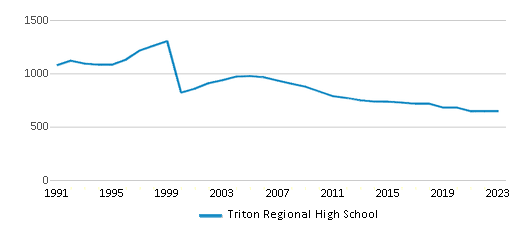
Gender %
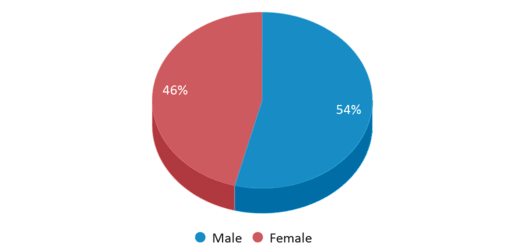
Total Classroom Teachers
57 teachers
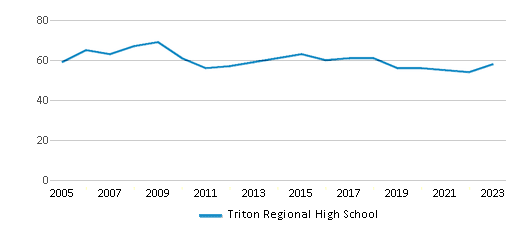
Students by Grade
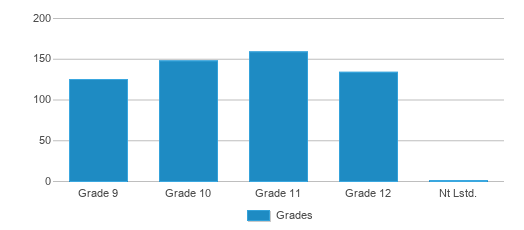
School Rankings
Triton Regional High School ranks within the top 30% of all 1,631 schools in Massachusetts (based off of combined math and reading proficiency testing data).
The diversity score of Triton Regional High School is 0.22, which is less than the diversity score at state average of 0.65. The school's diversity has stayed relatively flat over five school years.
Overall Testing Rank
#480 out of 1631 schools
(Top 30%)
(Top 30%)
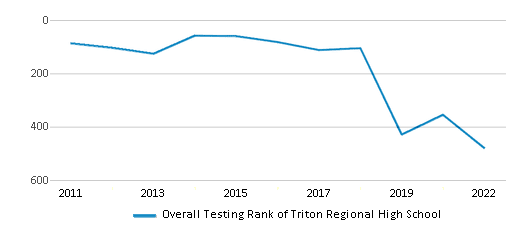
Math Test Scores (% Proficient)
45-49%
41%
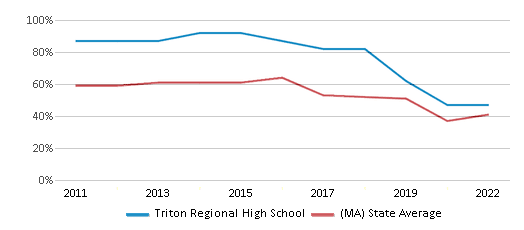
Reading/Language Arts Test Scores (% Proficient)
60-64%
44%
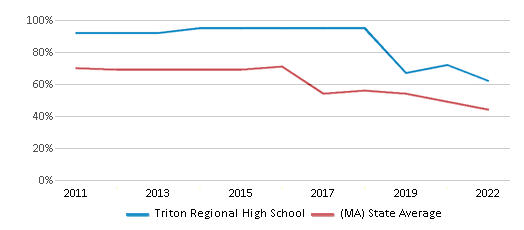
Science Test Scores (% Proficient)
45-49%
44%
Student : Teacher Ratio
10:1
12:1
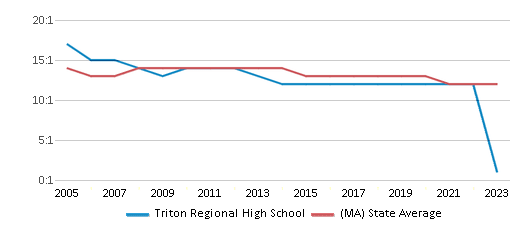
American Indian
n/a
n/a
Asian
3%
7%
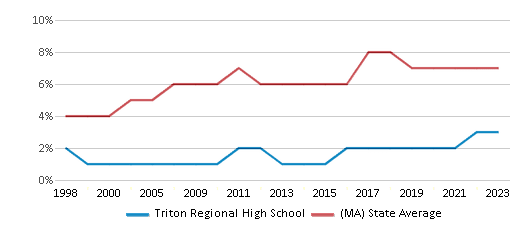
Hispanic
6%
25%
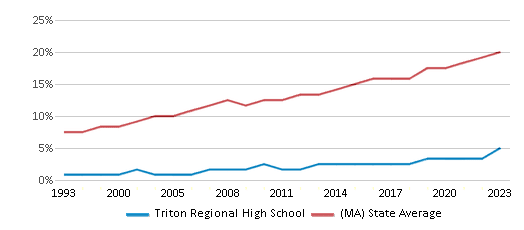
Black
1%
10%
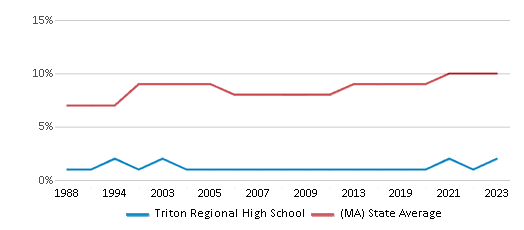
White
88%
53%
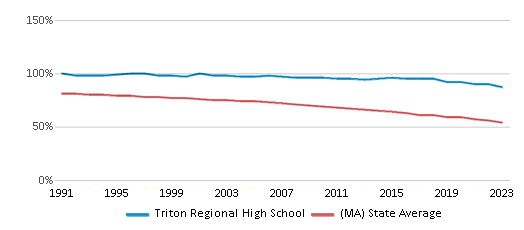
Hawaiian
n/a
n/a
Two or more races
2%
5%
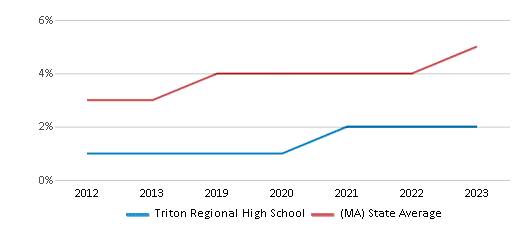
All Ethnic Groups
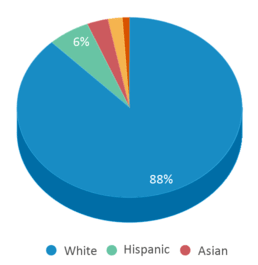
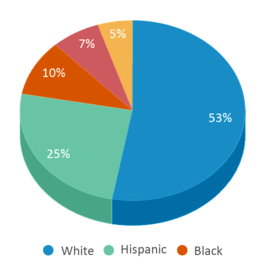
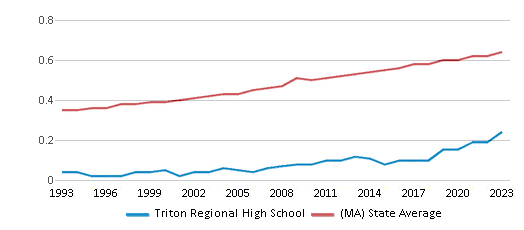
Graduation Rate
85-89%
90%
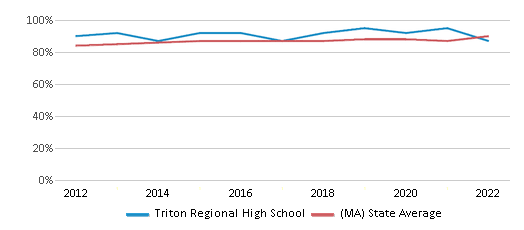
Participates in the National School Lunch Program (NSLP)
Yes
Eligible for Free Lunch
22%
35%
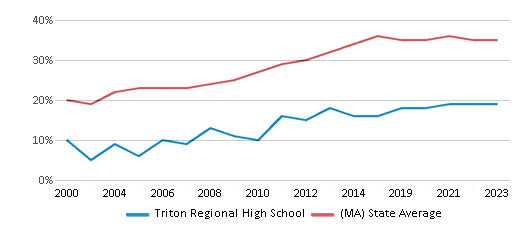
Eligible for Reduced Lunch
3%
4%
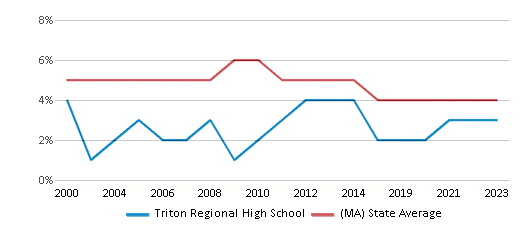
School Statewide Testing
School District Name
Source: National Center for Education Statistics (NCES), MA Dept. of Education
Profile last updated: 02/09/2025
Frequently Asked Questions
What is Triton Regional High School's ranking?
Triton Regional High School is ranked #480 out of 1,631 schools, which ranks it among the top 30% of public schools in Massachusetts.
What schools are Triton Regional High School often compared to?
Triton Regional High Schoolis often viewed alongside schools like Newburyport High School by visitors of our site.
What percent of students have achieved state testing proficiency in math and reading?
45-49% of students have achieved math proficiency (compared to the 41% MA state average), while 60-64% of students have achieved reading proficiency (compared to the 44% MA state average).
What is the graduation rate of Triton Regional High School?
The graduation rate of Triton Regional High School is 85-89%, which is lower than the Massachusetts state average of 90%.
How many students attend Triton Regional High School?
567 students attend Triton Regional High School.
What is the racial composition of the student body?
88% of Triton Regional High School students are White, 6% of students are Hispanic, 3% of students are Asian, 2% of students are Two or more races, and 1% of students are Black.
What is the student:teacher ratio of Triton Regional High School?
Triton Regional High School has a student ration of 10:1, which is lower than the Massachusetts state average of 12:1.
What grades does Triton Regional High School offer ?
Triton Regional High School offers enrollment in grades 9-12 (offers virtual instruction).
What school district is Triton Regional High School part of?
Triton Regional High School is part of Triton School District.
School Reviews
5 10/24/2009
The quality of education at Triton exceeds area schools in the choices of AP and Honors classes. As of late the only programs that have been cut have been Foods, All other programs are intact and vary widely in choice. Athletic teams at Triton continue to receive academic and sportsmanship awards on a yearly basis. The schools have all been remodeled or newly rebuilt. Parents are involved at all levels.
2 1/11/2007
The quality of this school is dismal. The teacher/student ratio is so high that it does not permit proper learning. Parents must fund all extracurriculars by 100%. All programs are in jeapordy, the administration as failed in all areas. The school committe is combative. The school has been put on warning status bu the New England Association of schools. This school is in danger! A modern failure!
Review Triton Regional High School. Reviews should be a few sentences in length. Please include any comments on:
- Quality of academic programs, teachers, and facilities
- Availability of music, art, sports and other extracurricular activities
Recent Articles

What Is A Charter School?
Explore the world of charter schools in this comprehensive guide. Learn about their history, how they operate, and the pros and cons of this educational innovation. Discover key facts about charter schools, including admission policies, demographics, and funding, as well as what to look for when considering a charter school for your child.

10 Reasons Why High School Sports Benefit Students
Discover the 10 compelling reasons why high school sports are beneficial for students. This comprehensive article explores how athletics enhance academic performance, foster personal growth, and develop crucial life skills. From improved fitness and time management to leadership development and community representation, learn why participating in high school sports can be a game-changer for students' overall success and well-being.

February 05, 2025
Understanding the U.S. Department of Education: Structure, Impact, and EvolutionWe explore how the Department of Education shapes American education, from its cabinet-level leadership to its impact on millions of students, written for general audiences seeking clarity on this vital institution.





